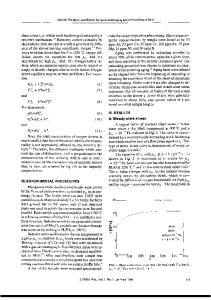Dynamic strain aging and hydrogen-induced softening in alpha titanium
- PDF / 901,117 Bytes
- 11 Pages / 598 x 778 pts Page_size
- 87 Downloads / 350 Views
I.
INTRODUCTION
UNDERSTANDING the interaction of hydrogen with titanium-base materials is important so that their properties can be predicted reliably.t~J Titanium alloys have a large affinity for hydrogen, the addition of which has a considerable effect on their microstructures and mechanical properties. Because of hydride formation, hydrogen causes embrittlement at near-room temperatures. At elevated temperatures, however, the hexagonal close-packed (hcp) a phase transforms to the more workable body centered cubic (bcc) /3 phase. The hydrogen lowers the transformation temperaturesf21and therefore increases the ductility and improves the workability through its effect on the phase composition.t3~ In order to model the properties of two-phase Ti-H alloys, it is necessary to know the effect of hydrogen on the properties of the single phases. In most cases, the solution of hydrogen in single-phase metallic materials has been reported to increase the flow stress; H'5,6] softening has only been observed in a small number of investigations.t6 ~z] Matsui and co-workerst7,8,91 have observed that the flow stress of high-purity iron decreases over the temperature range 200 to 300 K in the presence of hydrogen, whereas only strengthening is detected in impure iron. The first effect was ascribed to a hydrogen-induced increase in the dislocation mobility and the second was associated with the interaction of dislocations with hydrogen-impurity complexes. Hydrogen-enhanced dislocation mobility was detected in a series of transmission electron microscope (TEM) studies of several metals, including titanium, by Robertson and co-
O.N. SENKOV, on leave from the Institute of Solid State Physics, Russian Academy of Sciences, Moscow Region 142432, Russia, is Visiting Scientist, Department of Metallurgical Engineering, McGill University. J.J. JONAS, Professor, is with the Department of Metallurgical Engineering, McGill University, Montreal, PQ, Canada H3A 2A7. Manuscript submitted October 3, 1995. METALLURGICALAND MATERIALSTRANSACTIONS A
workersY ~ No macroscopic softening was observed, however, under the same conditions. In contrast to the macroscopic observations of Matsui and co-workers,tT,s,91 the TEM results showed that the hydrogen-induced increase in the dislocation mobility was often greater in materials containing impurities. Birnbaum and Sofronist6J interpreted these observations in the framework of elastic interactions between the mobile dislocations and the impurities that were shielded by the presence of the hydrogen atmosphere. Their mechanism therefore supports an earlier suggestion of Bemsteint~3~ that hydrogen reduces the lattice friction stress through an interaction with solute atoms, particularly interstitials, and facilitates dislocation movement in this way. Recently, Senkov and Jonast14a have reported the occurrence of hydrogen-induced softening in alpha titanium and hydrogen-induced hardening in beta titanium of commercial purity. The addition of hydrogen was found to decrease the flow stress, work hardening r
Data Loading...











